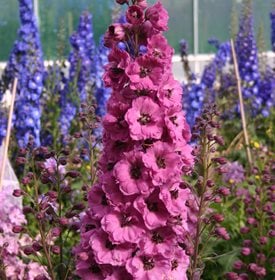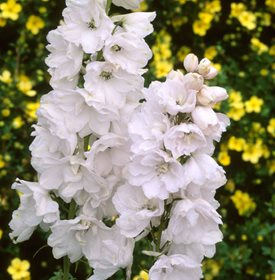DELPHINIUMS: HOW TO GROW & CARE FOR PERENNIAL DELPHINIUM
Learn how to plant and care for colorful delphinium flowers in your gardenDelphiniums bring unrivaled height and color to summer gardens with their showy spikes of vibrant flowers. The most common colors are shades of blue or purple, but there are others available. They bloom with single, semi-double or double flowers, also called florets.
Delphiniums can be high-maintenance, needing just the right conditions. They prefer cool, mild summers with low humidity. Plant them in a spot with adequate moisture and well-draining soil. Thankfully, new strains of hybrids are being developed that aren’t as fussy.
On this page: Basics | Types | Planting | Care | Pictures | Design Ideas | Cutting & Arranging | Alternatives
On this page:
- BASICS
- TYPES
- PLANTING DELPHINIUMS
- DELPHINIUM CARE
- DELPHINIUM PICTURES
- DESIGN IDEAS
- CUTTING & ARRANGING DELPHINIUMS
- ALTERNATIVES TO GROWING DELPHINIUMS
DELPHINIUM BASICS
Zones:
3-7; better planted annually in warmer climates.
Height/Spread:
Varies by type. The tallest varieties are found within the Delphinium elatum group, with stalks regularly 5 to 6 feet tall (with some reaching 8 feet) and a spread of 2 feet. The D. belladonna group averages 3 to 4 feet tall with a spread of 2 feet. Dwarf varieties, like D. grandiflorum, range 1 to 2-feet tall and 12 to 18 inches wide.
Exposure:
Delphinium plants require 6 to 8 hours of sun a day, and gentle morning and early afternoon sun is preferred. The roots need cool, moist shade.
Bloom Time:
Summer (June - July)
Color:
Delphiniums bloom in a wide array of colors including true blues, purple, lavender, pink, scarlet, white, and rarely yellow. Small flower centers are called ‘bees’ and may be white, tan, brown, black or striped.
Are delphiniums poisonous?
All delphiniums are considered toxic and parts of the plant and flower may cause severe discomfort to humans and animals if ingested. Gloves and long sleeves should be worn when working with delphiniums, as contact with the foliage can result in skin irritation.
Are delphiniums deer-resistant?
Delphiniums are resistant to deer and rabbits.
TYPES OF DELPHINIUMS
The most popular delphiniums belong to the D. elatum, D. belladonna, D. grandiflorum and hybrid groups.
- Elatum Group: This clump-forming perennial blooms with numerous single, semi-double, or double flowers in early to mid-summer. Flowers to 2-1/2 inches across fill stalks that are commonly 5 to 6 feet tall. Growing this variety may not be for the beginning gardener, as they are fairly high maintenance.
- Belladonna Group: This upright perennial grows flower stalks that bloom with branched spikes of single or double, 1 to 2-1/2 inch flowers. Belladonnas are comprised primarily of hybrid crosses of D. elatum and D. cheilanthum and range 3 to 4 feet tall.
- Grandiflorum Group: Also called Chinese or Siberian delphinium, this variety has a compact, bushy habit and grows 1 to 2 feet tall and nearly as wide. Grandiflorums bloom blue or white flowers mid-summer and tend to have a higher heat tolerance than other delphinium species.
- Pacific Giants: The Pacific hybrids, also known as Pacific Giants, can grow up to 4-6 feet tall and include popular cultivars like 'Black Knight', 'Galahad', 'King Arthur', 'Blue Jay' and 'Blue Bird'.
- New Zealand Hybrids: The New Zealand hybrids are medium-sized, and include such favorites as 'Pagan Purples', 'Dasante Blue', and the New Millennium series.
PLANTING DELPHINIUMS
When to plant:
Plant potted delphiniums in the spring.
Where to plant:
Delphiniums should be planted in an area that receives 6 to 8 hours of sun per day, preferably morning sun. They need shelter from strong winds and rain downpours to avoid damage to the tall flower stalks. Standing water causes crown and root rot, so a well-drained site is a must. To prevent disease, plant in an area that allows good air circulation and where they’re not overcrowded.
How to plant:
Prepare the planting site with organic matter or compost to 1 foot deep. Plant delphiniums in a hole that is twice the diameter of the container and backfill with soil that has been well-mixed with the organic matter. The top of the rootball should be level with the soil.
DELPHINIUM CARE
Pruning:
For best flowering, new plants should be thinned to 2 to 3 good shoots when they are 3 inches high. Established plants can be thinned to 5 to 7 of the best shoots. Cut the main stalk down after flowering to the level of its smaller side shoots, which will bloom secondarily with slightly smaller flowers. To encourage a second, but smaller, bloom in late summer or early autumn, cut the stalks to the ground just after flowering. Prune the entire plant to the ground after it wilts in autumn.
Soil:
Well-drained, humus-rich soil is a must, preferably slightly alkaline. Although mulch helps preserve moisture in the soil, if it is applied too closely to the stems it can cause them to rot. For finicky delphiniums, soil quality plays a major role in success or failure.
Amendments & fertilizer:
Apply a balanced, slow-release liquid fertilizer every 2 to 3 weeks. Avoid high-nitrogen fertilizers. Composted manure applied in autumn helps supplement these heavy feeders.
Watering:
Water deeply during rainless periods, but don’t allow standing water. Delphiniums like it moist, but water that lingers causes crown and root rot. Water delphiniums at the base, keeping the foliage dry to help prevent disease.
Propagation:
According to the National Garden Bureau, September to March is the best time to seed delphiniums. Use fresh seeds, as germination can be poor after a year. Presoaking is recommended to improve the germination rate, along with temperatures of 65 at night and 75 during the day while germinating. Cover seeds with only one-eighth inch of soil and keep evenly moist, but not wet as this can cause them to rot. Smaller rather than larger tray size is also recommended. Transplant after plants have two true sets of leaves.
It is common for delphiniums not to bloom the first year, so be patient and you should see them come to life in the second year. Seeds collected from hybrids growing in the garden may not produce offspring that bloom true to color.
Diseases and pests:
Delphiniums are susceptible to a host of diseases including powdery mildew, Southern blight, bacterial and fungal spots, gray mold, crown and root rot, rust and others. Planting your delphiniums in a well-ventilated area and keeping the foliage dry will go a long way in preventing disease. Care should be taken to protect young plants from snails and slugs, as they can cause considerable damage. Delphiniums are also commonly plagued by cyclamen mites, aphids and nematodes.
If your delphiniums are performing poorly, the book Essential Perennials offers these tips:
- Black spotted foliage can mean cyclamen mites.
- Curled & distorted leaves usually indicate aphids.
- Yellow foliage and stunted growth may be caused by nematodes (this can also be from a lack of fertilizer).
- Black, foul-smelling decay at the base is bacterial crown or root rot caused by poor drainage.
- Disfigured stems and foliage along with stunted growth can be a sign of powdery mildew.
Support:
Other than the dwarf varieties, delphiniums require staking. Their hollow stems will break when blown in the wind or when the flowers become weighed down from rainfall. Stake them with sturdy supports and attach at 12- to 18-inch intervals.
DELPHINIUM PICTURES
LANDSCAPE DESIGN TIPS
- Delphiniums are a popular choice for cottage-style gardens.
- Grow tall delphiniums at the back of a mixed border or as a centerpiece to an island flower bed for vertical accent.
- For the best show, plant delphiniums in groups or massed.
- Plant up against a fence for added support and wind protection.
- Joe Pye weed, hyssop and salvia make good garden companions.
CUTTING AND ARRANGING DELPHINIUMS
Follow these helpful tips for using delphiniums as cut flowers:
- Cut delphiniums at a 45-degree angle when many of the flowers are already open.
- Rinse the stems well before putting them in the vase.
- Remove any foliage that will be underwater to help keep the water clean.
- Freshen the cut ends of the stems and change out the water every 2 to 3 days.
- Display the arrangement in a cool location, out of direct sunlight.
ALTERNATIVES TO GROWING DELPHINIUMS
Many gardeners steer clear of growing delphiniums in their garden because of their high-maintenance needs. If you’re not up for the challenges of growing delphinium flowers but still want the look of tall flower stalks, you might consider one of these alternatives:
RELATED:
Color in the Garden
21 Blue Flowers for Your Garden
Summer Garden Ideas










